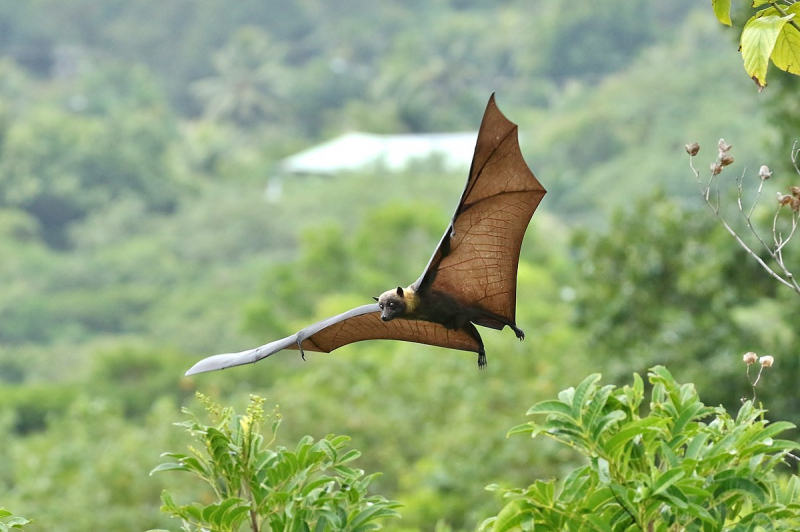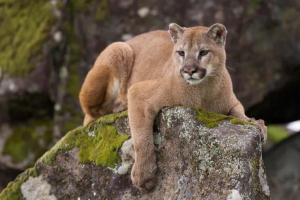Top 10 World's Amazing Forest Animals
Forest is a natural resource covering one-third of the earth’s land area. Being loaded with biodiversity, a forest is covered with plants and is a dwelling for ... read more...various animals. It offers food, and shelter to diverse animals. Below is a list of the amazing forest animals in the world, let's find out!
-
The Saola (Pseudoryx nghetinhensis), also called spindle horn, Asian unicorn, or infrequently, Vu Quang bovid, is one of the world's rarest large mammals, a forest-dwelling bovine native to the Annamite Range in Vietnam and Laos. It was described in 1993 following the discovery of remains in Vũ Quang National Park by a joint survey of the Vietnamese Ministry of Forestry and the World Wide Fund for Nature. Since then, saolas have been maintained in captivity several times, however only for brief periods because they passed away within a few weeks or months. Do Tuoc, a forest ecologist, and his colleagues initially mentioned the species in 1992. In 1993, the first image of a living saola was captured in captivity. The most recent was captured in 2013 by a camera that was activated by movement in a jungle in central Vietnam.
Saolas are enormous mammals that weigh 80 to 100 kg, measure around 150 cm long, and have a typical lifespan of 8 to 10 or 11 years. This mammal has two piercing horns on its head, an asymmetrical coat of skin covered in brown hair all over its body, a short tail with white markings, and thick, hazy brown hair on its abdomen and forelimbs. It is a 37 mph running herbivore that eats a variety of plants and bushes.

WWF 
Tạp chí Môi trường -
Pteropus (suborder Yinpterochiroptera) is a genus of megabats that are among the largest bats in the world. They are commonly known as fruit bats or Flying Foxes, among other colloquial names. It is found in Mangrove forests, marsh, and tropical forests of Southeast Asia, Australia, and Madagascar. Their populations are particularly susceptible to dangers like overhunting, culling, and natural calamities because of their sluggish life histories. By overhunting, six different flying fox species have vanished in the contemporary era. Flying foxes are frequently attacked because of their actual or imagined involvement in causing agricultural damage. By aiding in the regeneration of forests through seed dissemination, they are environmentally advantageous. By pollinating plants, they advance both human and environmental interests.
The lying fox is 11-13 inches long making it one of the largest bats in the world and weighs 1.4-2.4 lb and has life anticipation of 15 to 30 years. Fruit, other plant materials, and occasionally insects are eaten by flying foxes. They use their strong sense of smell to discover supplies. The majority of them, but not all, are nocturnal. Since they are unable to echolocate, they navigate with excellent vision. They have long lifespans and modest reproductive rates, with most species' females giving birth to just one young each year.

Encyclopedia Britannica 
Wikipedia -
The Jaguar (Panthera onca) is a large cat species and the only living member of the genus Panthera. It is found in tropical rainforests and wetlands of South America. The jaguar is threatened by habitat loss, habitat fragmentation, poaching for trade with its body parts, and killings in human-wildlife conflict situations, particularly with ranchers in Central and South America. It has been listed as Near Threatened on the IUCN Red List since 2002. The wild population is thought to have declined since the late 1990s. Priority areas for jaguar conservation comprise 51 Jaguar Conservation Units (JCUs), defined as large areas inhabited by at least 50 breeding jaguars. The JCUs are located in 36 geographic regions ranging from Mexico to Argentina.
It is the third largest cat species in the world with a body length of up to 1.85 m and a weight of up to 158 kg (348 lb). Although some individuals have a melanistic black coat, most have a pale yellow to tan colored coat covered in dots that turn into rosettes on the sides. The jaguar's powerful bite allows it to pierce the carapaces of turtles and tortoises, and to employ an unusual killing method: it bites directly through the skull of mammalian prey between the ears to deliver a fatal blow to the brain.

Wikipedia 
Greenoxx -
The Mountain Gorilla, which can reach heights of 4 to 6 feet and weighs between 135-220 kg, is one of the biggest species of primates in nature. It has a life expectancy of 35 years and inhabits the high, steep mountain forests of four different national parks in Africa—Uganda, Rwanda, and the Democratic Republic of the Congo. A gorilla has thick fur since the temperature at this altitude is extremely low. Mountain gorillas have their own unique nose prints, just as every human has an unmatched fingerprint.
The mountain gorilla is a diurnal animal that consumes significant amounts of food throughout the day in order to maintain its enormous size. It rests in the late morning and around noon, then forages again in the late morning and early afternoon before sleeping at night. Every evening, a new nest is built by a gorilla from the nearby plants as a place to sleep. Only babies share their mothers' nests for sleep. Unless it is chilly and cloudy, in which case they frequently stay longer in their nests, they depart their sleeping areas when the sun rises at around 6 am.

WWF 
African Wildlife Foundation -
The Scarlet Macaw is a huge and stunning member of the macaw family. They live in Central and South America's wet evergreen woods. They are renowned for having vibrant plumage, blue backs and brilliant red fronts, and yellow upper wings with green edges. Another distinguishing characteristic of a scarlet macaw is its powerful, curled beak. The tip is black, while the upper section is white. An adult scarlet macaw measures 80 to 90 cm in length and can weigh up to 1.5 kg. They fly quite well and may go at speeds of up to 35 mph. Scarlet macaws have a longer lifespan as well. These animals have a lifespan of 40-50 years. It is said to be that scarlet macaws in captivity can live up to 75 years.
The magnificent, scarlet macaw is also among the most intelligent birds in the world. They are easily taught language, sounds, and tricks while kept in captivity. A well-trained scarlet macaw is claimed to be able to recognize both colors and shapes. Scarlet macaws are boisterous parrots as well. They have a variety of vocalizations, including screeches and squawks. Their primary food sources include insects, fruits, seeds, and nuts. Scarlet macaws have a powerful, curved beak that can readily crush any nuts.

iStock 
The Spruce Pets -
Of all the monkeys found in the new world, Howler Monkeys (genus Alouatta, monotypic in subfamily Alouattinae) are among the biggest. They are well known for their howls, which may reverberate across a deep rainforest for more than a mile. The woods of South and Central America are home to these monkeys. Threats include habitat destruction, predation by humans, and capture for use as pets or zoo animals. There are fifteen known species. They were previously categorized in the family Cebidae, but are now in the Atelidae.
The howler monkey has a lifespan of 15–20 years and is between 22 and 36 inches in height and 6.8 and 10 kg in weight. Different types of howler monkeys come in a variety of hues, including red, black, or brown, and have dense hair on their whole bodies and a fur-covered face. It has a tail that is as long as its body and helps it pluck the fruit. It also has enormous, circular nostrils that allow it to smell food from a distance of two kilometers away. This carnivore consumes other birds' eggs as well as fruits, buds, flowers, nuts, leaves, and berries.

Wikipedia 
National Geographic Kids -
Tree-Kangaroos are marsupials of the genus Dendrolagus, adapted for arboreal locomotion. They inhabit the tropical rainforests of New Guinea and far northeastern Queensland, along with some of the islands in the region. All tree-kangaroos are considered threatened due to hunting and habitat destruction. They are the only true arboreal macropods.
Tree kangaroo has a length of 19-35 inches and weighs around 5.9-15 kg. Its size is a bit lighter than usual kangaroo and has a life expectancy of 18-25 years. They have longer, broader hind feet with longer, curved nails than terrestrial kangaroos. They also have paws and foot soles that have a sponge-like grip. When navigating through the trees, tree-kangaroos significantly longer, pendulous tail gives them better balance than terrestrial kangaroos. As with real kangaroos, movement on the ground is accomplished by hopping. Like terrestrial kangaroos, tree kangaroos do not sweat to cool their bodies; instead, as an adaptive method of behavioral thermoregulation, they lick their forearms and let the liquid evaporate.

WWF 
iStock -
Orangutans are great apes native to the rainforests of Indonesia and Malaysia. They are now found only in parts of Borneo and Sumatra, but during the Pleistocene, they ranged throughout Southeast Asia and South China. One of the most intelligent ape species is the orangutan. They make intricate sleeping nests out of branches and other vegetation each night, using a variety of specialized tools. The apes' capacity for learning has been thoroughly investigated. Within populations, there might be distinct cultures.
Orangutans spend most of their time in trees, making them the most arboreal of the great apes. Their bodies are covered in reddish-brown hair, and their arms and legs are proportionately long and short. Male adults often weigh 75 kg, whereas female adults typically weigh 37 kg. Younger subordinate men do not, and they more closely resemble adult females. Dominant adult males grow characteristic cheek pads or flanges and make extended cries that entice females and frighten competitors. Of all the great apes, orangutans are the most isolated; social connections typically form between mothers and their dependent children. The majority of an orangutan's diet consists of fruit, though they also eat foliage, bark, honey, insects, and bird eggs. Both in the wild and in captivity, they have a lifespan of over 30 years.

Wikipedia 
World Wildlife Fund -
The African Forest Elephant (Loxodonta cyclotis) is one of the two living African elephant species. It is native to humid forests in West Africa and the Congo Basin. It grows to a shoulder height of 2.4 meters, making it the smallest of the three types of extant elephants. Tusks that point straight down and erupt between the ages of three and five are present in both sexes. It resides in family units of up to 20 people. It has been dubbed the "megagardener of the forest" since it eats leaves, seeds, fruit, and tree bark. It contributes significantly to maintaining the composition and structure of the Guinean Forests of West Africa and the Congolese rainforests.
In 1900, the species' first scientific description appeared in a book. Overhunting during the 20th century precipitated a dramatic drop in population; by 2013, it was believed that fewer than 30,000 people were left. Poaching, habitat fragmentation, and habitat loss pose threats to it. Across range of countries, populations' conservation status varies. On the IUCN Red List, the species has been classified as Critically Endangered since 2021.

WWF 
EcoWatch -
Anacondas are not venomous, and their bite does not make them deadly, despite what certain movies might have us believe. The Green Anaconda, one of the biggest snakes in the world, can reach a length of 30 feet, which is two times the size of a giraffe. It is the largest snake on Earth. It is found in swamps, marshes, and streams in tropical rainforests of Amazon and Orinoco Basins and has an average life expectancy of 10 years. They are creatures that can silently approach their victim, strike it with force, then smother and kill it with their muscular bodies. The prey is subsequently swallowed completely by them. They frequently hunt a variety of prey, including jaguars, humans, deer, capybaras, and wild boars.
The male species of green anacondas look for females for mating between the months of April and May, however, they spend most of their time alone. There are situations where different kinds of green anacondas may go after the same female. Numerous males are wrapped around a single female in what is known as "breeding balls" in an effort to mate. There have been reports of female green anacondas eating smaller male anacondas, a cannibalistic trait that occasionally manifests in these animals.

Reptiles Magazine 
Encyclopedia Britannica






























